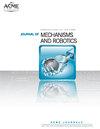具有全身可捕获性的仿人机器人推恢复的分区感知稳定性控制
IF 3.2
4区 计算机科学
Q2 ENGINEERING, MECHANICAL
Journal of Mechanisms and Robotics-Transactions of the Asme
Pub Date : 2023-03-08
DOI:10.1115/1.4056956
引用次数: 0
摘要
摘要为使仿人机器人在扰动下成功恢复推力,必须选择合适的稳定动作。现有的方法是有限的,因为它们通常是从降阶模型推导出来的,忽略了系统特定的方面,如摆腿动力学或运动学和驱动限制。在本研究中,引入了一种在增强质心(COM)状态空间中基于分区的方法来描述全身类人机器人的可捕获性。一步可捕获边界是通过一种基于优化的方法计算的,该方法将全身系统特性与矢状面上的全阶非线性系统动力学结合起来,包括与地面的接触相互作用以及在步进后实现完全停止的条件。利用1步可捕获边界和平衡状态边界,量化不同策略和接触对保持或恢复推送恢复平衡的相对贡献。计算出的边界也作为明确的标准整合到分区感知推送恢复控制器中,该控制器监控机器人的COM状态,以选择性地利用脚踝、髋关节或捕获的步进策略。推恢复仿真实验验证了稳定性边界在仿人机器人响应扰动时通过适当的平衡动作充分发挥其平衡能力方面的有效性。总体而言,具有整个系统特性和动力学的系统特定可捕获性优于典型的降阶模型。本文章由计算机程序翻译,如有差异,请以英文原文为准。
Partition-Aware Stability Control for Humanoid Robot Push Recovery With Whole-Body Capturability
Abstract For successful push recovery in response to perturbations, a humanoid robot must select an appropriate stabilizing action. Existing approaches are limited because they are often derived from reduced-order models that ignore system-specific aspects such as swing leg dynamics or kinematic and actuation limits. In this study, the formulation of capturability for whole-body humanoid robots is introduced as a partition-based approach in the augmented center-of-mass (COM)-state space. The 1-step capturable boundary is computed from an optimization-based method that incorporates whole-body system properties with full-order nonlinear system dynamics in the sagittal plane including contact interactions with the ground and conditions for achieving a complete stop after stepping. The 1-step capturable boundary, along with the balanced state boundaries, are used to quantify the relative contributions of different strategies and contacts in maintaining or recovering balance in push recovery. The computed boundaries are also incorporated as explicit criteria into a partition-aware push recovery controller that monitors the robot’s COM state to selectively exploit the ankle, hip, or captured stepping strategies. The push recovery simulation experiments demonstrated the validity of the stability boundaries in fully exploiting a humanoid robot’s balancing capability through appropriate balancing actions in response to perturbations. Overall, the system-specific capturability with the whole-body system properties and dynamics outperformed that derived from a typical reduced-order model.
求助全文
通过发布文献求助,成功后即可免费获取论文全文。
去求助
来源期刊

Journal of Mechanisms and Robotics-Transactions of the Asme
ENGINEERING, MECHANICAL-ROBOTICS
CiteScore
5.60
自引率
15.40%
发文量
131
审稿时长
4.5 months
期刊介绍:
Fundamental theory, algorithms, design, manufacture, and experimental validation for mechanisms and robots; Theoretical and applied kinematics; Mechanism synthesis and design; Analysis and design of robot manipulators, hands and legs, soft robotics, compliant mechanisms, origami and folded robots, printed robots, and haptic devices; Novel fabrication; Actuation and control techniques for mechanisms and robotics; Bio-inspired approaches to mechanism and robot design; Mechanics and design of micro- and nano-scale devices.
 求助内容:
求助内容: 应助结果提醒方式:
应助结果提醒方式:


